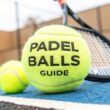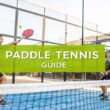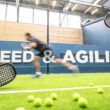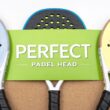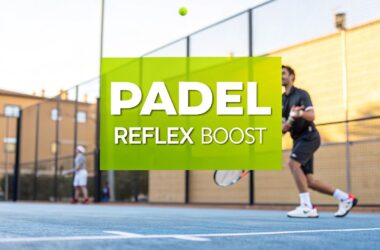So, you’re ready to dive into the incredible world of padel? Awesome. Before you even think about stepping on that court, let’s talk about gear. Getting the right setup from the start will make a massive difference in how you play, how quickly you improve, and most importantly, how much fun you have.
Think of it as your foundational toolkit. It’s not about buying the most expensive stuff, but about getting the right stuff for the job.
Your Foundational Padel Toolkit
The three absolute essentials you need to get started are a padel racket, padel balls, and padel shoes. Each one is built specifically for this game, which is a unique mashup of high-speed volleys and strategic wall plays. They are not the same as their tennis cousins.
And this isn't just a niche sport anymore. Padel is exploding. The global padel equipment market was already valued at around €500 million back in 2022 and is growing way faster than tennis, thanks to huge investments in getting more people to play and building more courts.
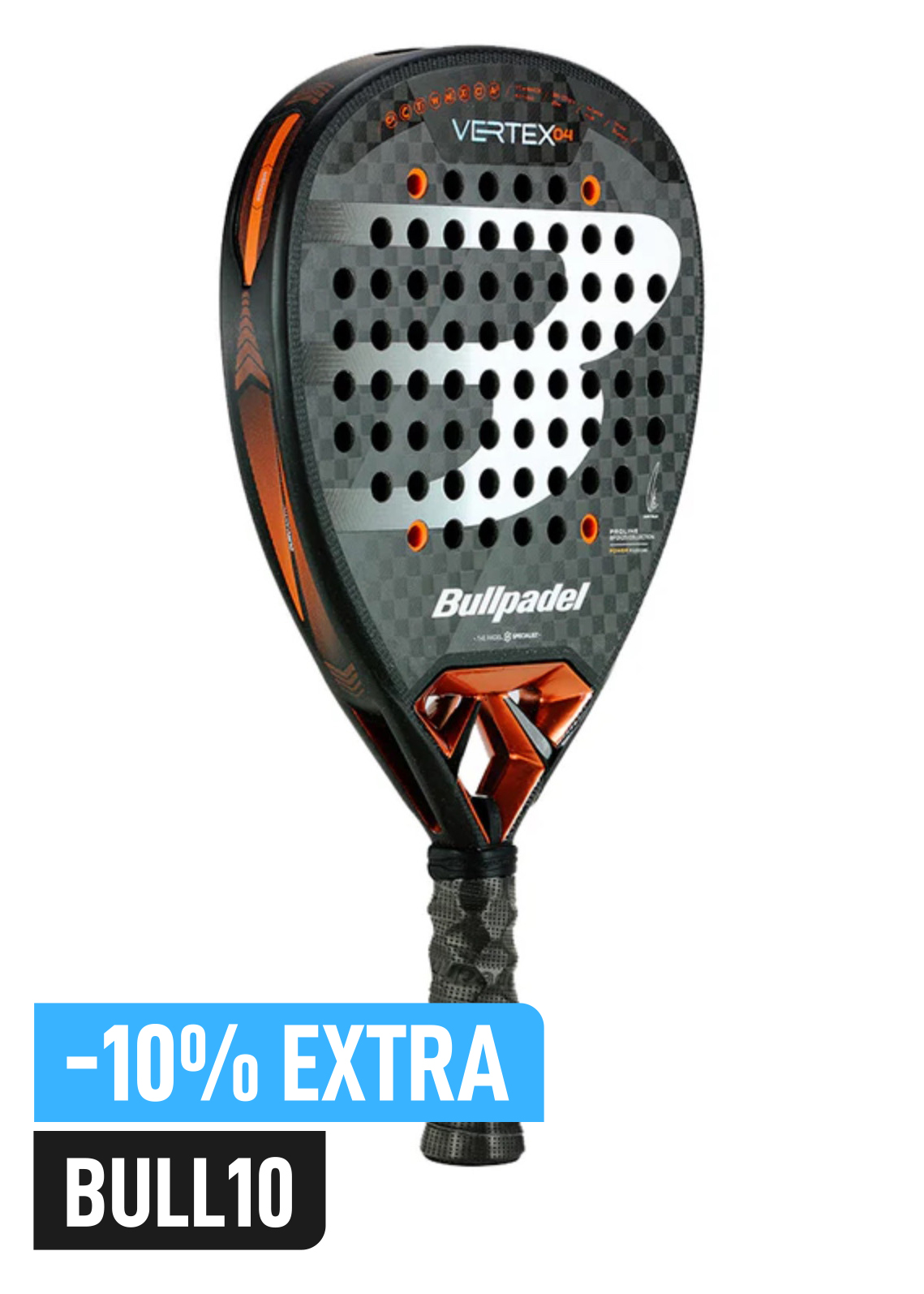
Buy the best padel gear to level up your next game!
CHECK OUT this deal from Padel Market!Get ready to take your game to the next level with the latest padel gear from Padel Market! Fast EU and Worldwide Shipping
The Three Core Essentials
Let's get straight to it. These are the non-negotiables, the pieces of gear that directly shape how you move, hit the ball, and connect with the court.
- Padel Racket: Forget strings. A padel racket is a solid, foam-core paddle peppered with holes. This design gives you a completely different feel for the ball, offering a fantastic blend of power and control.
- Padel Balls: They might look just like tennis balls, but they're softer. With lower internal pressure, they bounce slower and more predictably off the court and those signature glass walls.
- Padel Shoes: The sole is the secret here. You need a specific herringbone or mixed pattern designed to grip the sandy, artificial turf while still letting you pivot and turn on a dime without getting stuck.
Honestly, the biggest mistake I see new players make is showing up with their old tennis gear. Using equipment actually made for padel isn't just about performance—it's crucial for preventing injuries and truly getting a feel for what makes this sport so addictive.
Getting a handle on the right equipment is a fundamental step in any sport. For a general overview of equipment and advice in another popular sport, see this guide on golf gear and tips. If you're just starting out and want to learn more about the game itself, check out our deep dive into https://padelrumors.pages.dev/news/what-is-padel-2/. This guide will make sure you’ve got the right toolkit from day one.
How to Choose Your Padel Racket
Your padel racket is the single most important piece of gear you’ll buy. It's not just a tool; it’s a direct extension of your arm on the court, influencing everything from how you control a delicate bandeja to the power you unleash in a smash. Picking the right one can feel like a huge task with all the different shapes, weights, and materials out there, but once you grasp the basics, it all starts to click.
Think of it like this: a carpenter wouldn’t use a sledgehammer for fine, detailed woodwork. In the same way, you need a racket that actually fits your style of play and current skill level. Whether you’re a beginner just trying to get the ball over the net or an advanced player hunting for that perfect finishing shot, the right racket is out there waiting for you.
This visual guide lays out the essential gear, showing how your racket, balls, and shoes are the foundation of your game.
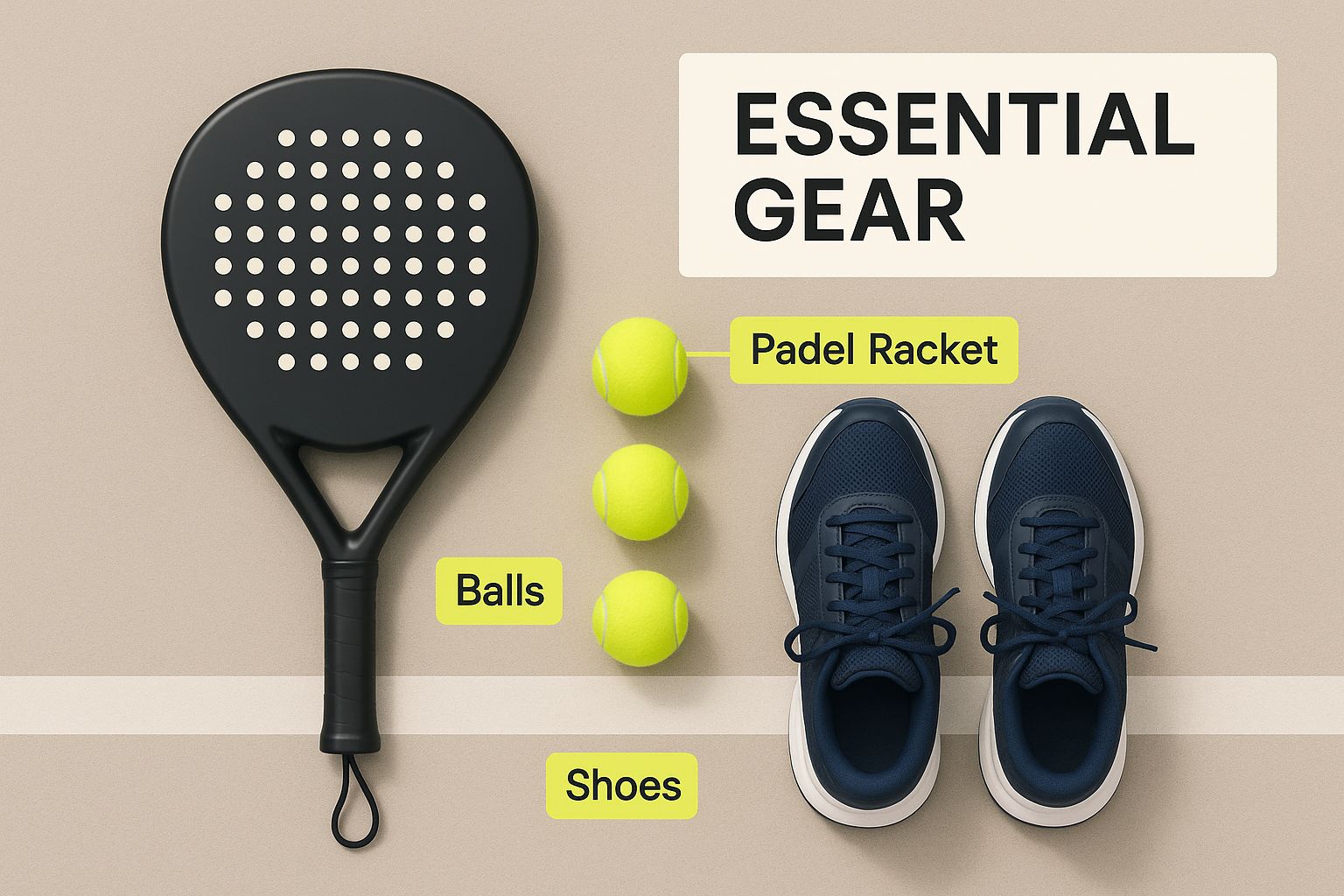
As the image shows, while you can add plenty of accessories later, your performance really boils down to these three key items.
Understanding Racket Shapes
The first big decision is the shape. Padel rackets come in three main flavors, and each one is designed to help a different type of player.
- Round Rackets: Think of this as your shield. Round rackets have their balance point low (closer to your hand) and boast a big, forgiving sweet spot right in the middle. This design gives you maximum control and makes it easier to hit good shots even when you're slightly off-center. It's the perfect choice for beginners and defensive players.
- Diamond Rackets: This one is the hammer. Diamond-shaped rackets push the balance high, concentrating weight toward the top of the head. This gives you extra leverage for explosive power, but the tradeoff is a smaller, less forgiving sweet spot. These are built for advanced, aggressive players who can consistently find the center of the racket.
- Teardrop Rackets: This is your all-arounder, the jack-of-all-trades. A teardrop racket is the perfect hybrid, blending the best of both worlds. It gives you a great mix of power and control, with a balance point sitting somewhere between the round and diamond shapes. It’s an excellent go-to for intermediate players who have developed a more complete game.
The Role of Weight and Balance
Beyond just the shape, the racket's weight and balance are massive factors. They directly affect your swing speed, how much power you can generate, and even your risk of injury. Getting this right is absolutely key to feeling comfortable on the court.
A lighter racket (usually under 365 grams) is much easier to maneuver, allowing for quicker reactions at the net. The catch? You'll have to generate more of the power yourself. On the other hand, a heavier racket (over 375 grams) provides more natural power and stability, but it can be tougher to swing and might lead to arm fatigue if you're not used to it.
The balance point is the racket's center of mass. A head-heavy balance (like in diamond rackets) adds serious punch to your smashes, while a head-light balance (found in round rackets) makes the racket feel more nimble for better control.
Core Materials: EVA vs. Foam
The "engine" inside your racket is its core, which is usually made of either EVA rubber or Foam. This material is what determines the feel of the ball on impact and how much "spring" you get.
EVA is the industry standard. It’s a denser, firmer rubber that gives you excellent control and holds up well over time. It comes in different densities—harder EVA delivers more power, while softer EVA provides a more comfortable, cushioned feel.
Foam, by contrast, is much softer and gives you a bigger rebound effect. This means it helps you generate power with less effort, making it a great choice for players with elbow or shoulder issues. The only real downside is that foam cores tend to wear out faster than their EVA counterparts. You can dive deeper into these materials and explore more options by checking out this great guide to padel racket types.
Putting It All Together: A Comparison
Choosing the right padel racket is all about matching its features to your personal needs. A beginner needs something completely different from what a competitive player uses, and understanding why is half the battle.
To make it simple, here’s a quick breakdown of how the three main racket shapes stack up against each other.

Buy the best padel gear to level up your next game!
CHECK OUT this deal from Padel Market!Get ready to take your game to the next level with the latest padel gear from Padel Market! Fast EU and Worldwide Shipping
Padel Racket Shape Comparison
| Racket Shape | Primary Benefit | Best For | Sweet Spot Location | Power vs. Control |
|---|---|---|---|---|
| Round | Maximum Control | Beginners, Defensive Players | Large, Central | Control |
| Diamond | Maximum Power | Advanced, Aggressive Players | Small, High on the Face | Power |
| Teardrop | Versatility | Intermediate, All-Around Players | Mid-High on the Face | Balanced |
Ultimately, the best padel racket isn't the most expensive or the most powerful one on the shelf. It’s the one that feels like a natural extension of your arm and complements your game. Start with a racket that gives you confidence and control. As your skills grow, you can start experimenting with different shapes and weights to find that perfect match that helps you own the court.
Selecting the Right Padel Balls and Shoes
While your racket might feel like the star of the show, two other pieces of gear are just as crucial for your performance and safety on the court. It’s a common rookie mistake to just grab your old tennis stuff, assuming it’ll do the job. This section will break down why specialized padel balls and shoes aren’t just nice-to-haves—they're essential for playing the game right and staying injury-free.
The right equipment completely changes how you feel and play on the court, making your movements smoother and your shots more reliable. Let’s start with the one thing that's always in the middle of the action: the ball.
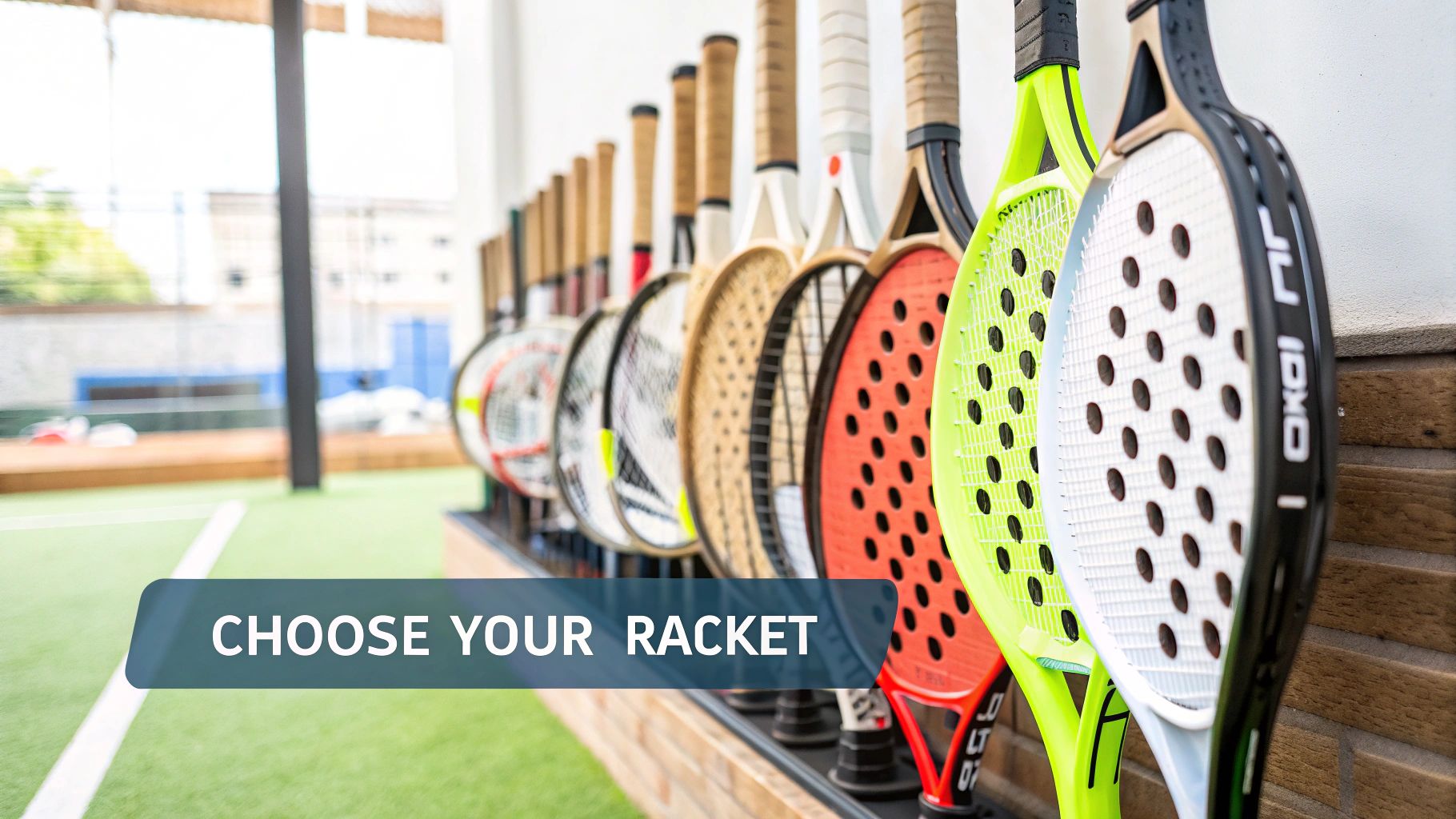
Decoding the Padel Ball
At first glance, a padel ball and a tennis ball look like twins. They're both fuzzy and yellow, but the real difference is on the inside. A padel ball has lower internal pressure, and this small detail completely transforms the game's dynamics.
Because of this lower pressure, the ball bounces less than its tennis counterpart. This creates a slower, more controlled rebound off the court and, most importantly, off the glass walls. That predictable bounce is the very foundation of padel strategy. It allows for those long, exciting rallies and tricky wall shots that would be impossible with a high-flying tennis ball.
Using the correct padel ball is non-negotiable. Its slower speed gives you more time to react and set up your shots, making the game more accessible for beginners and more strategic for advanced players.
The worldwide obsession with padel has kicked off a massive industry for its gear. In fact, the padel equipment market was valued at a staggering $198.5 billion in 2024 and is expected to hit $214.58 billion by the end of 2025. This explosion shows just how many players are investing in the right equipment to get the most out of the sport.
Why Your Footwear Matters Most
If the ball sets the pace of the game, your shoes determine if you can keep up. Padel is all about explosive, multi-directional movement—we're talking quick sprints to the net, sudden lunges to the side, and rapid pivots. Your footwear is your first line of defense against injury and your secret weapon for agility.
Your everyday running shoes or even tennis shoes designed for hard courts just aren't cut out for a padel court, which is usually artificial turf with a light dusting of sand. Padel shoes are engineered specifically for this environment, with features built to handle the unique physical demands of the sport.
Key Features of Padel Shoes
When you're shopping for padel shoes, keep your eyes on three critical features. Each one directly impacts your safety and performance on that sandy turf.
- The Outsole: This is the most important part of a padel shoe. The best and most common pattern is the herringbone (or clay court) sole. This design gives you an amazing grip on the sandy surface, stopping you from slipping but still letting you pivot and turn smoothly.
- Cushioning and Support: Padel involves a ton of high-impact movement. Good shoes will have plenty of cushioning in the midsole to absorb shock, taking the pressure off your knees and ankles. They also have reinforced sides to keep you stable during those sharp lateral cuts.
- Durability: The gritty court surface can chew through regular shoes in no time. Padel shoes are built with tougher materials, especially around the toe and inner foot, to withstand all the dragging and friction.
Choosing the right shoes is a direct investment in your long-term love for the game. They not only boost your mobility and confidence but also play a huge role in preventing common injuries like ankle sprains and joint strain. To get a deeper dive into padel balls and what makes them unique, check out our guide on the essentials of the padel ball. Taking a little extra time to pick the right footwear means you can play harder, move faster, and stay on the court longer.
Dressing for Success on the Padel Court
What you wear on the padel court is so much more than a fashion statement—it’s a crucial part of your gear. The right apparel has a direct impact on your performance and comfort, letting you focus on the game instead of getting distracted by chafing or overheating. While you might be tempted to just grab an old gym shirt, padel-specific clothing is actually designed for the sport's unique demands.
This means putting technical fabrics way ahead of standard cotton. Materials like polyester and nylon blends are built to be moisture-wicking, pulling sweat away from your skin to keep you dry and comfortable. This is a game-changer during those long, intense rallies, preventing that heavy, sticky feeling that can really weigh you down.
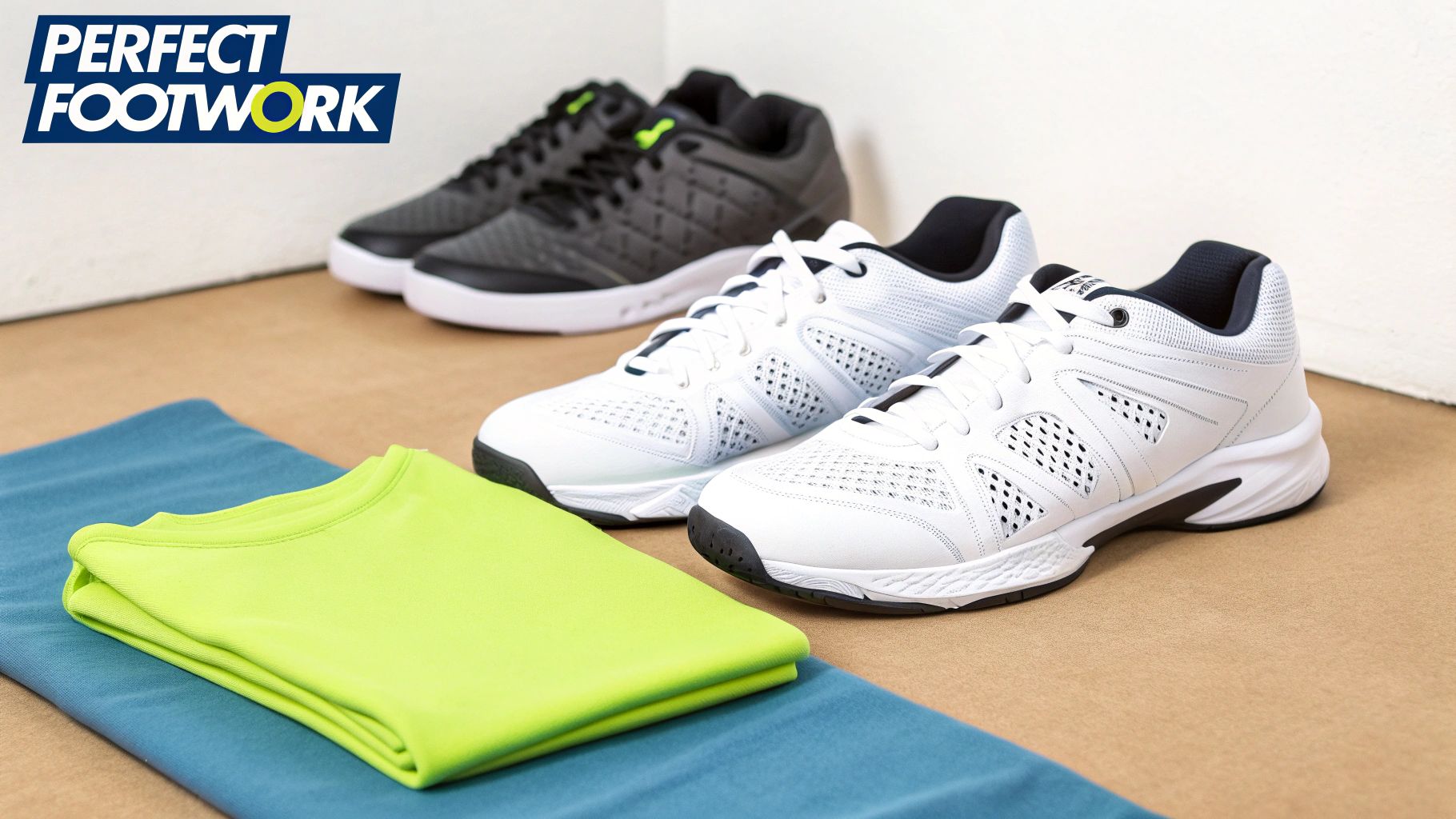
Beyond the Fabric
When you're picking out your gear, look for features that support the explosive, multi-directional movements of padel. Modern padel apparel often has four-way stretch technology, which lets the fabric move with you in every direction. This freedom of movement is absolutely essential when you're lunging for a drop shot or winding up for a powerful smash.
Here’s a quick rundown of what to look for:
- Shirts: Go for lightweight, breathable tops. Flatlock seams are a huge plus, as they prevent skin irritation during long matches.
- Shorts and Skirts: Make sure they offer great flexibility. Many padel shorts and skirts even come with built-in compression liners for extra support and handy ball storage.
Think of your apparel as a support system. Proper clothing helps regulate your body temperature and allows for a full range of motion, which can cut down on muscle fatigue and even help prevent injuries. It’s an investment in both your comfort and your performance.
The Finishing Touches and Court Etiquette
Beyond your main outfit, don't overlook the small stuff—it can make a huge difference. Wristbands and headbands are great for managing sweat, keeping your hands and eyes clear for those crucial shots. Also, think about getting specialized socks designed for racquet sports.
Many modern padel socks offer targeted compression to boost blood circulation, which can help with muscle recovery and reduce fatigue. They also often feature reinforced cushioning and non-slip systems to give you better stability inside your shoe during quick changes of direction.
Finally, always be mindful of the club's dress code. Most padel clubs stick to a smart-casual athletic standard, which means proper sportswear is expected. Leave the jeans and non-athletic t-shirts at home. Showing up in the right gear not only shows respect for the facility and your opponents but also ensures you step onto the court feeling confident and ready to play your best. A quick look at the club’s website beforehand can clear up any questions.
Essential Padel Accessories to Elevate Your Game
Once you’ve got your racket, balls, and shoes sorted, there’s a whole world of accessories waiting to make your time on court more comfortable, protect your gear, and even sharpen your game. Sure, none of these are strictly necessary to play, but they can make a massive difference in your overall experience.
Think of them as smart upgrades. We can break them down into two camps. First, the "must-haves"—the bits of kit that are so useful you'll wonder how you ever played without them. Then, there are the "game-changers," which offer a more specialized edge to dial in your comfort and performance.
Must-Have Padel Accessories
These are the workhorses you’ll find in almost every regular player's bag. They solve common on-court problems so well that most people consider them non-negotiable after just a few games.
An overgrip is probably the single most important accessory you can buy. It’s a thin, tacky tape that you wrap over your racket's handle. Why bother? It does two critical jobs: it gives you a much better feel and control over the racket, and it soaks up sweat to keep your grip locked in. They wear out, so swap them regularly to keep that fresh, secure feeling.
Next up is a racket protector. This is just a tough, sticky strip that you slap onto the top edge of your racket's frame. Let's be honest, in padel, you're going to scrape your racket against the glass or the fence—it's inevitable. A protector takes the hit, saving your frame from the chips and nicks that can seriously shorten its lifespan.
Game-Changing Padel Equipment
Once you've got the basics covered, these accessories start to look pretty appealing. They might not seem essential at first, but they can make a real difference to your comfort and how you look after your gear, letting you focus completely on the match.
A dedicated padel bag is a fantastic investment. Unlike a standard backpack, these are built with specific compartments for rackets, shoes, balls, and your personal stuff. Everything stays protected, organized, and ready to go.
Don't overlook the small details that save you from wear and tear. Things like vibration dampeners and wristbands aren't just for the pros—they're practical tools for anyone looking to reduce strain and manage the physical demands of a fast game.
Wristbands and headbands are simple but incredibly effective. They stop sweat from running down your arms onto your hands or dripping into your eyes. This means a firmer grip and clearer vision when you’re lining up a crucial shot.
A vibration dampener is a tiny rubber gadget you pop into the holes near the bottom of the racket face. It’s designed to soak up some of the shock that travels up your arm when you hit the ball. If you're prone to tennis elbow or just general arm soreness, this little piece can bring a surprising amount of relief.
The growing popularity of these specialized items just goes to show how much the sport is booming. The global padel market, which covers everything from equipment to court construction, was valued at a cool $222.3 million in 2023 and is expected to nearly double to $426.2 million by 2032.
This explosion proves that players and investors are all-in on every part of the game. You can dig deeper into this incredible growth in recent padel sports industry analysis. By picking the right accessories, you're not just buying stuff; you're investing in a better, more comfortable, and way more enjoyable game.
Common Padel Equipment Questions Answered
Even after you get a handle on the different types of gear, there are always a few questions that pop up for players, whether you're a seasoned pro or just stepping onto the court for the first time. Getting straight answers can help you make smarter buys, save some cash, and ultimately have more fun during your matches.
This section tackles the most common questions we hear, cutting through the noise to give you practical advice you can put to use right away. We'll cover everything from equipment lifespan to what a beginner really needs to get started.
How Often Should You Replace Your Padel Racket?
This is the big one, and the answer isn't as simple as marking a date on your calendar. It really comes down to one thing: how often you play. Think of your racket’s foam core like the cushioning in a running shoe. Every time you smash the ball, that foam compresses and loses just a little bit of its springiness.
For a casual player hitting the court once a week, a quality racket can easily last 18 to 24 months. But if you're a competitive player training and playing multiple times a week, that core is going to get tired much faster. Serious players often find they need a new racket every 6 to 9 months to keep their performance at its peak.
A dead giveaway that your racket is on its last legs is a change in how it feels and sounds. If it starts to make a dull thud on impact, feels like it’s lost its punch, or you notice more vibrations traveling up your arm, the foam core has probably given up.
It's not just the inside that wears out. The racket's surface can become smooth over time, which will kill your ability to put any real spin on the ball. Paying attention to these subtle drops in performance is a much better guide than just following a strict timeline.
Can You Use Tennis Balls for Padel?
They look almost identical, so it's a fair question. But using tennis balls for a padel match is a common rookie mistake that completely changes the game. The key difference is the internal pressure. Padel balls are designed with lower pressure, which means they bounce lower and slower than their tennis counterparts.
This might sound like a minor detail, but it’s absolutely central to what makes padel, well, padel. That slower, more controlled bounce is what enables the long, strategic rallies and the clever use of the glass walls that define the sport.
Here’s what happens when you bring tennis balls to a padel court:
- The bounce is way too high and fast. Good luck playing a controlled shot off the back wall.
- Rallies die quickly. The ball just flies around too wildly for any real strategy to unfold.
- The game turns into a power contest, losing all the finesse and tactical play that makes it so addictive.
For a quick, casual hit, you might get by. But if you want to experience the true rhythm of the game, you’ve got to use proper padel balls.
What Is the Most Important Gear for a Beginner?
When you’re just starting out, it’s easy to feel overwhelmed by all the gear. But if you have to prioritize one thing, what should it be? Surprisingly, the most critical piece of equipment for any beginner is a good pair of padel shoes.
Most people think the racket is the number one priority, and while a forgiving, round-shaped racket is definitely helpful, the wrong shoes can lead directly to injury. The artificial turf and sand on a padel court demand a specific kind of grip that your everyday running shoes just can't deliver.
Padel shoes feature a herringbone or omni-court sole that provides the perfect mix of grip and give. They let you make sharp, sudden movements without slipping, but also allow you to pivot smoothly without your foot getting stuck and twisting an ankle. That stability is your best defense against injury and will help you build confidence as you learn to move around the court.
How Do You Properly Care for Your Racket?
Buying a great racket is only half the battle. Taking proper care of it will extend its life and keep it performing at its best. Padel rackets are sensitive souls—they don't like extreme temperatures or moisture, which can break down the foam core and weaken the frame.
The single most important thing you can do is store your racket in a dedicated padel bag, ideally one with a thermal-lined pocket. This protects it from crazy temperature swings. Seriously, never leave your racket in a hot car trunk or a freezing garage.
Here are a few more essential care tips:
- Use a frame protector. This is just a simple adhesive strip that goes around the top edge of the frame, protecting it from nicks and scrapes against the glass or the court floor.
- Keep it dry. If your racket gets wet, wipe it down with a dry cloth before putting it away.
- Change your overgrip often. A fresh grip absorbs sweat better and gives you a secure hold, which prevents the racket from twisting or slipping in your hand during a critical point.
Follow these simple steps, and you’ll get a lot more life out of your most important piece of gear.
At Padel Rumors, we're dedicated to helping you find the perfect gear and improve your game. From beginner guides to professional insights and the latest news, we have everything you need. Explore our comprehensive resources at https://padelrumors.pages.dev.


